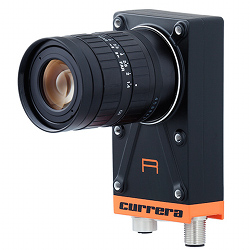Industry group aims to promote embedded vision technology
Jun 1, 2011 — by Eric Brown — from the LinuxDevices Archive — viewsA new Embedded Vision Alliance (EVA) industry group announced its founding members and launched its website devoted to promoting embedded vision technology in applications ranging from digital signage to automotive vision systems. Founded by BDTI, along with Xilinx and IMS Research, the 16-member group includes semiconductor manufacturers Freescale, Nvidia, and Texas Instruments.
Founded by embedded processor consultancy Berkeley Design Technology, Inc. (BDTI), with the early assistance of Xilinx and IMS Research, the Embedded Vision Alliance (EVA) intends to promote the rapid growth of computer vision in embedded systems. A further goal is to provide system design engineers with the tools required to effectively incorporate embedded vision technology, says the group. The EVA says it plans to provide design engineers with information, practical know-how, and industry standards.
Other members are said to include Analog Devices, Apical, Avnet Electronics Marketing, CEVA, CogniVue, Freescale, National Instruments, Nvidia, Tokyo Electron Device, MathWorks, Ximea, XMOS, and Texas Instruments.
For now, the group is focused on its new open-access website (see link farther below). The site is intended to serve as a source of practical information for embedded vision system design. In the future, the site will host newsletters, educational webinars, industry reports, and the publication of technology standards.
The embedded vision field spans processors, image sensors, lenses, lighting, networking, and development tools that apply intelligence to cameras and other imaging devices, says the EVA. These components are said to be used in applications ranging from surveillance to safety to robotics in industries including industrial, medical, automotive, security, and consumer home automation and entertainment.
Kinect shows the way
 In his founding statement, Jeff Bier, president of BDTI, singles out the Microsoft Kinect as an inspiration. The Kinect game controller add-on for the Xbox 360 has quickly become the fastest-selling consumer electronics device in history, shipping more than 10 million units in five months, according to Blier.
In his founding statement, Jeff Bier, president of BDTI, singles out the Microsoft Kinect as an inspiration. The Kinect game controller add-on for the Xbox 360 has quickly become the fastest-selling consumer electronics device in history, shipping more than 10 million units in five months, according to Blier.
"Adding computer vision to embedded systems creates phenomenal new products, markets, and opportunities," writes Bier. "From automobiles that prevent accidents to security cameras that prevent crimes, embedded vision will proliferate across a multitude of markets."
 Intelligent video surveillance is a particularly thriving segment of embedded vision. EVA member Texas Instruments (TI) aims many of its DaVinci ARM/DSP hybrid system on chips (SoCs) at intelligent surveillance. Its recent TMS320DMVA1 SoC, which is backward compatible with DaVinci SoCs, combines an ARM9 core, a new Vision analytics co-processor, and a codec co-processor. The SoC is offered in a Linux-ready DMVA1 IP camera reference design (pictured at left), says TI.
Intelligent video surveillance is a particularly thriving segment of embedded vision. EVA member Texas Instruments (TI) aims many of its DaVinci ARM/DSP hybrid system on chips (SoCs) at intelligent surveillance. Its recent TMS320DMVA1 SoC, which is backward compatible with DaVinci SoCs, combines an ARM9 core, a new Vision analytics co-processor, and a codec co-processor. The SoC is offered in a Linux-ready DMVA1 IP camera reference design (pictured at left), says TI.
The DMVA1's imaging technology is said to provide video stabilization, face detection, noise filtering, auto white balance, auto focus, auto exposure, and edge enhancement. Developers can also integrate TI's TMS320DM6435 DaVinci DSP with the design to "achieve advanced analytics capabilities," according to TI.
 Machine vision for industrial applications is another hot area. EVA member Ximea recently announced a series of Linux-compatible "smart cameras" for machine vision that include Intel Atom processors and color image sensors ranging from WVGA (752 x 480 pixels) to five megapixels. The Curerra-R devices (pictured at right) offer features including 1GB to 4GB of flash storage, microSD slots, VGA and Ethernet ports, and isolated digital I/O.
Machine vision for industrial applications is another hot area. EVA member Ximea recently announced a series of Linux-compatible "smart cameras" for machine vision that include Intel Atom processors and color image sensors ranging from WVGA (752 x 480 pixels) to five megapixels. The Curerra-R devices (pictured at right) offer features including 1GB to 4GB of flash storage, microSD slots, VGA and Ethernet ports, and isolated digital I/O.
Stated Vin Ratford, senior vice president of worldwide marketing and business development at Xilinx, "The momentum behind embedded vision applications is growing at an astounding rate and industry collaboration is needed to enable the technology's smooth adoption in new markets."
Stated Ian Weightman, president of market research firm IMS Research, "With hundreds of companies now developing embedded vision components, products and applications, the EVA can become the pivotal hub that not only educates companies on the potential of embedded vision, but also enables the industry to share ideas and best practices."
Stated Niels Anderskouv, vice president, Digital Signal Processing Systems, TI, "We are seeing consumer demand for 'sight' in every application growing rapidly. The future of that growth rests on companies that can work together to innovate, enable rapid development and provide software that allows customers to move quickly to meet that growth."
Availability
More information on the Embedded Vision Alliance may be found at the EVA website.
This article was originally published on LinuxDevices.com and has been donated to the open source community by QuinStreet Inc. Please visit LinuxToday.com for up-to-date news and articles about Linux and open source.